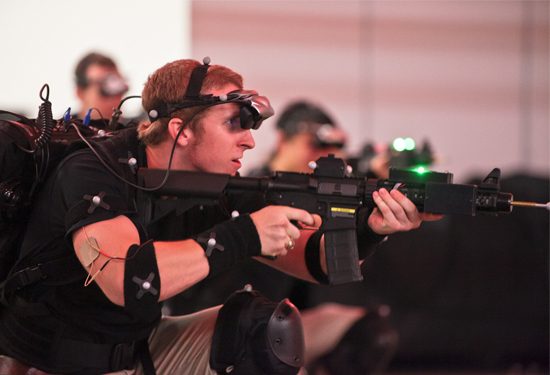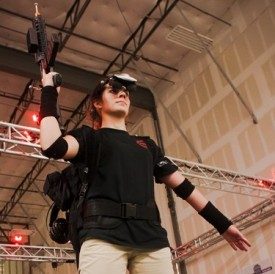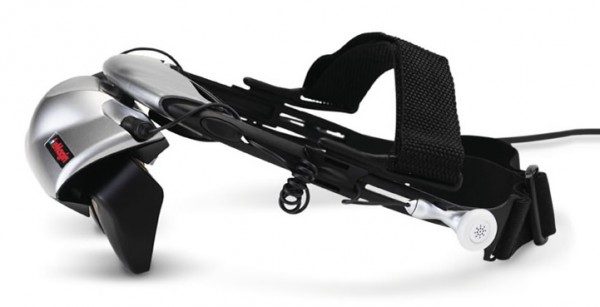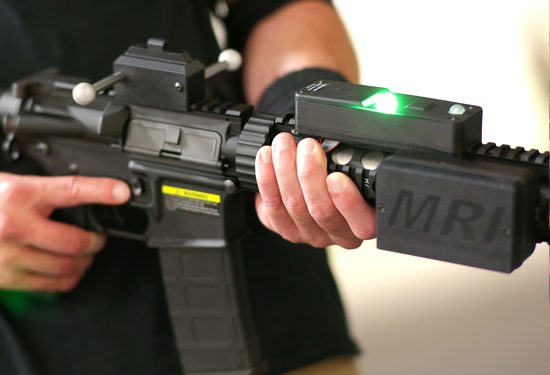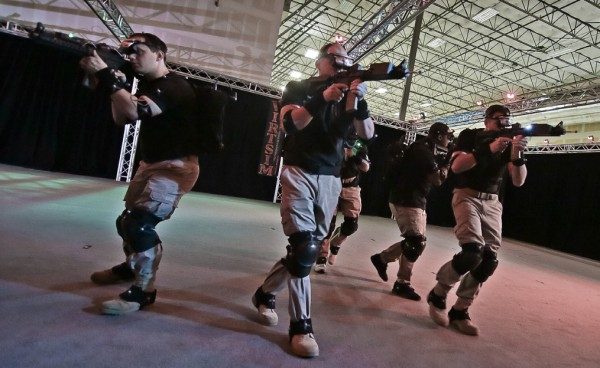VIRTSIM is a highly immersive virtual reality system which can pit squads of players against each other in a realistic virtual reality combat environment. The system utilizes full-motion body capture, VR headsets, gun props, and even shock-feedback. Unfortunately, the rather amazing-looking experience is not available in any sort of consumer capacity. Instead, VIRTSIM is relegated to non-entertainment purposes like military and emergency personnel training. Why can’t those that want to play virtual reality games get in on the fun?
Virtual Reality Simulator
VIRTSIM was created by US defense contractor Raytheon. The company, which has its hands in many different pies (including a recent $636 million contract for an ‘Exoatmospheric Kill Vehicle’ for space-based missile interception), designed the system for immersive military and emergency personnel training, not for gamers.
VIRTSIM is like Project Holodeck on steroids. The platform brings together a number of components to create an immersive virtual reality world.
Body Tracking
The foundation of the system is full-body motion tracking from Motion Reality Inc. (MRI) who has provided motion capture solutions for use in movies such as Avatar, King Kong, and Lord of the Rings. Users have reflective markers attached to them which reflect infrared light to a series of cameras which are used to determine the position of the user’s body and track the precise movements of their limbs. Simply put, this means that players motions are almost perfectly recreated in the virtual world. The game space can be as large as a basketball court, allowing for a wide range of scenarios such as breaching a full-sized office-building.
Head Mounted Display / VR Headset and Weapons
An HMD / VR headset is employed to immerse users into the virtual reality space. The HMD in use appears to be the eMagin Z800 3DVisor. The Z800 has 800×600 OLED displays, a 40 degree (diagonal) field of view, and displays a 3D stereoscopic view. An included head tracker allows the user to look around the virtual environment in 360 degrees. Squad mates can see the movement of their team in real time around them.
A realistic weighted weapon prop allows users to aim just like they would with a real gun. The prop has proper trigger pulls for firing and real clip reloading once the virtual weapon runs out of ammo. Furthermore the weapons have a force-feedback block on them to simulate sound and recoil with each shot. The weapon appears to be tracked with both markers and an IMU (motion sensor); this allows users to actually aim down the sights of the weapon like they would in real life by peering through their VR headset.
A Shocking Experience with Multiplayer
The weapons are designed to make firing quite realistic and VIRTSIM also offers feedback for when shots are taken. Using muscle-stimulation (ie: electric pulses), the system is designed to give users a jolt so that they know when they’ve been hit. Electrodes are placed on the triceps; getting hit causes the muscles to tense up suddenly.
VIRTSIM allows players to engage against AI opponents or even in virtual reality multiplayer scenarios with up to 13 people. Multiple VIRTSIM platforms can be remotely connected together to allow multiplayer gameplay from remote locations. This allows squads to train with each other or even play competitively against one another.
The entire experience is wireless, allowing users to move freely and naturally around the virtual reality game environment. A backpack houses the needed batteries and other components to make each user a self-contained avatar of the virtual world.
Why Gamers Can’t Have It, Yet
Although VIRTSIM seems to tick almost every box as an ideal virtual reality gaming platform, there’s a number roadblocks preventing this sort of experience from reaching consumers and gamers.
First and foremost is cost. The body tracking system in place uses professional movie-grade motion capture. I expect this part of the platform to cost upward of $100,000, if not more. The HMDs aren’t even cheap! The eMagin Z800 in use only has an 800×600 display and a 40 degree (diagonal) FoV and still costs around $1600 a piece — that’s even more than Sony’s HMZ-T1 and HMZ-T2 which have a higher resolution. Many of the other components are sure to be equally as expensive — from the gun replicas to the backpack processing units to the wireless transmitters; there’s a lot going on here and the costs add up quickly.
Let’s also not forget the necessary processing power. Real-time body tracking and subsequent scene rendering is not something that can be handled by your average desktop computer. Even if cost of the other components wasn’t a factor, just getting your hands on a PC (or array of PCs) capable of the necessary processing power, as a typical gamer, would be tough without a big budget.
These aren’t modular components either. Pretty much every component in use requires custom software to function properly with VIRTSIM. The software that controls the experience is likely to be quite complicated and not particularly easy to use or cheap.
Simply put, VIRTSIM is not made for a gaming audience. It’s the kind of virtual reality gaming experience you can achieve with a huge budget, but it remains well outside the boundaries of a consumer virtual reality platform.
It is at least good to know that these systems already exist and are proven. As the cost of components go down and the ease of use and deployment goes up, gamers will reap the benefits of systems like VIRTSIM which serve as proofs of concept.
For instance, Project Holodeck strives to accomplish much of the same immersion shown by VIRTSIM but with significantly lower cost and complexity. The Project Holodeck team hopes that this will make immersive virtual reality experiences of this kind accessible to a much wider audience.
Prices are likely to fall on many of the technologies necessary for such an experience as VR technology moves away from military and other professional simulations and into the world of mainstream entertainment. This is thanks to the competitive nature of marketing to consumers; you won’t have a successful product if your audience can’t afford it.
We’ve already seen a number of motion peripherals for body tracking hit the market at relatively affordable prices (like Kinect, Razer Hyrda, Leap Motion, and PlayStation Move). Competition in the consumer head mounted display space is heating up with HMDs / VR headsets like the Oculus Rift, Sony HMZ-T1/T2, and Silicon Micro Display ST1080 — all of which are priced less, and are perhaps better, than the eMagin Z800 employed by VIRTSIM. Smartphones are also helping — most of us now carry around a fairly capable computer that runs on its own power and is capable of wireless data transmission — a perfect solution to replacing those bulky backpacks. In due time the pieces of the puzzle will come together to create this level of immersion for a mainstream gaming audience. I think it’ll happen in the next 3 years, while simple HMD virtual reality gaming will happen in 2013.
If only Raytheon would set up VIRTSIM systems at special locations like tradeshows and arcades in the meantime — I’d definitely pay $20 for a spin!
Thanks to Joel Johnson of Mote and Beam for pointing out VIRTSIM

